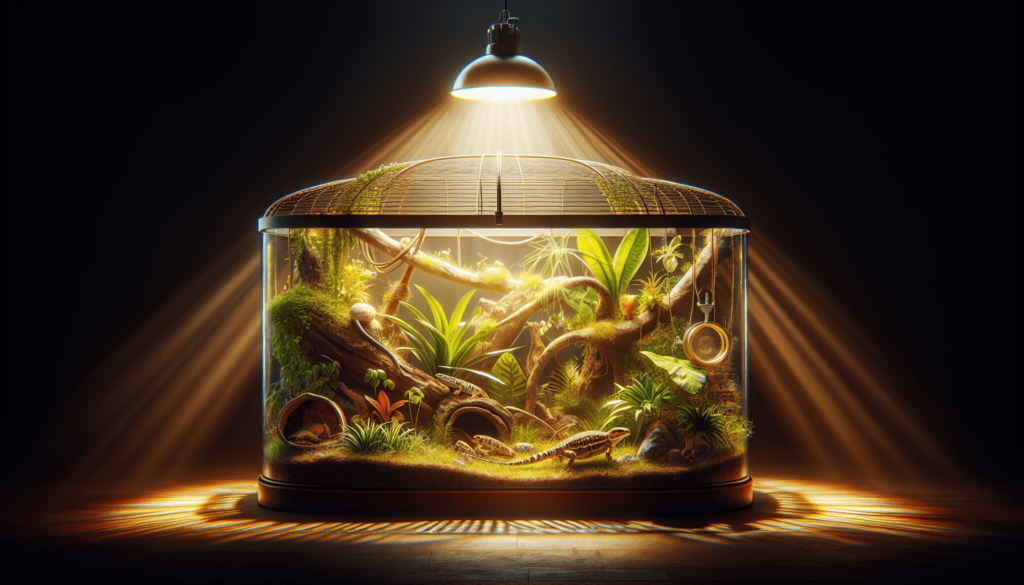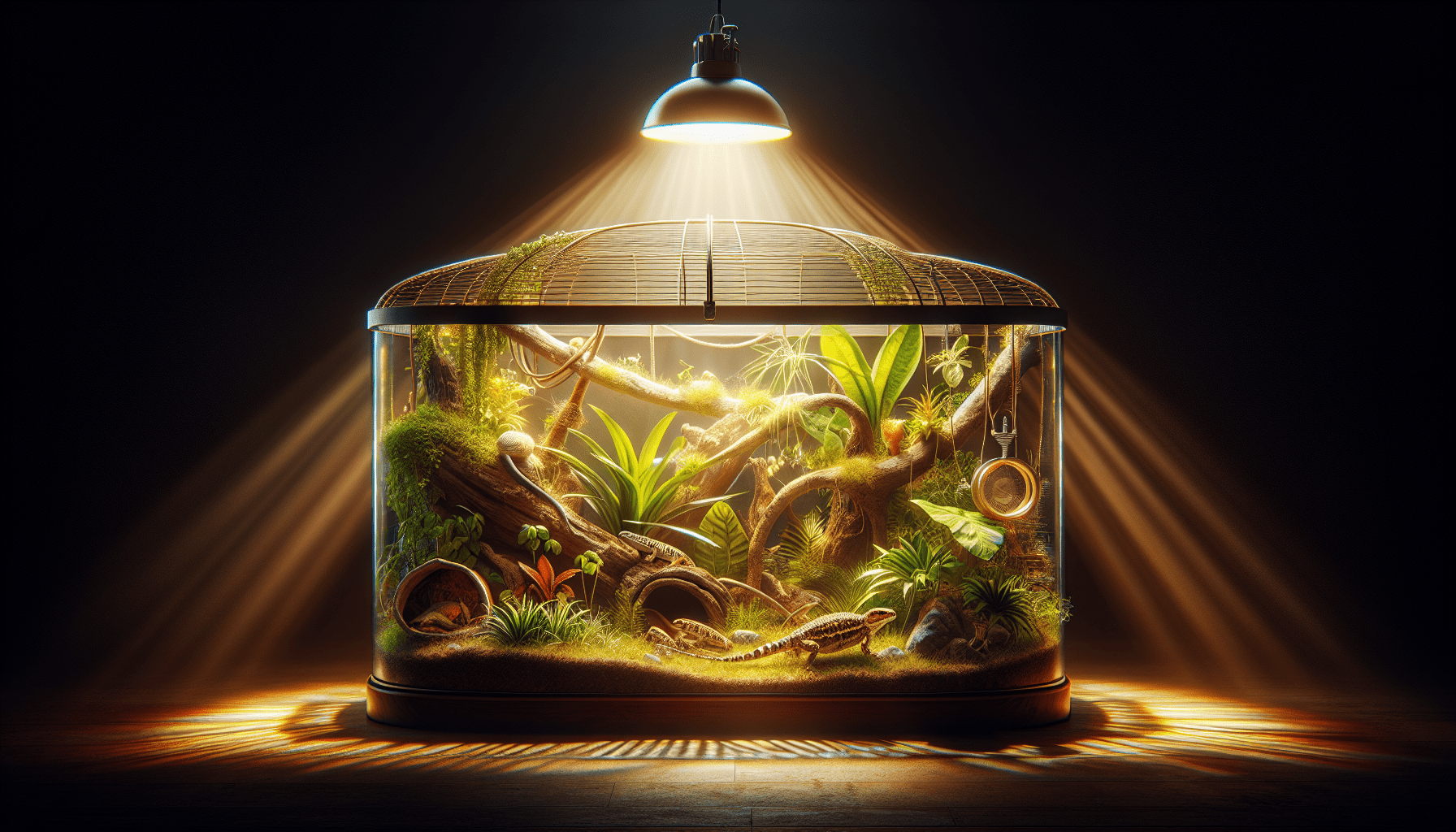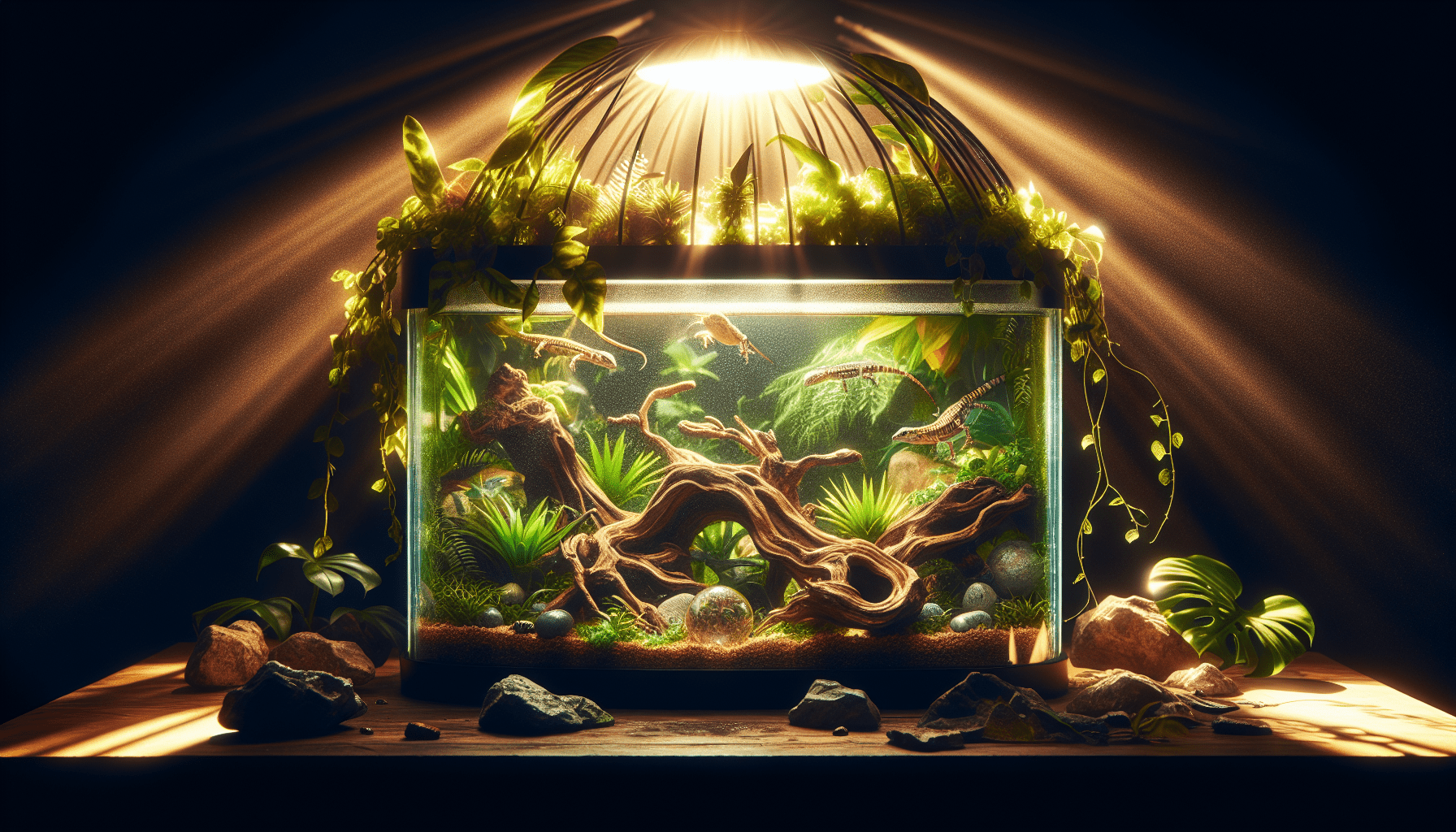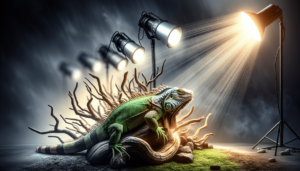
What Kind Of Lighting Do Reptiles Need?
If you have ever wondered about the ideal lighting for your pet reptile, you’re not alone. Understanding the specific lighting needs of reptiles is crucial for their overall health and well-being. Providing the right kind of lighting can replicate their natural habitat, regulate their body temperature, and even affect their behavior. In this article, we will explore the various types of lighting that reptiles require and why it is essential for their thriving existence. So, let’s shed some light on what kind of lighting reptiles truly need.

Natural vs Artificial Lighting
The importance of natural lighting
Natural lighting plays a crucial role in the overall health and well-being of reptiles. Reptiles, like any living creatures, have evolved to rely on natural sunlight for their daily activities. Exposure to natural light provides reptiles with essential ultraviolet (UV) radiation, which is vital for their physiological processes, including calcium metabolism, vitamin D synthesis, and overall growth and development. Natural light also helps regulate their internal clock, allowing them to establish natural circadian rhythms. In addition, natural lighting promotes natural behaviors, such as basking, foraging, and reproduction, by providing the appropriate intensity and color spectrum.
The role of artificial lighting
While natural lighting is ideal, artificial lighting plays a crucial role in reptile care, especially for those kept indoors. Artificial lighting helps recreate the necessary light spectrum and intensity that reptiles would receive in their natural habitat. It supplements natural light sources or provides a suitable alternative when natural light is insufficient or not readily available. Artificial lighting serves as a reliable and consistent light source, ensuring that reptiles receive the necessary UV radiation and lighting conditions for their overall health and well-being.
Balancing natural and artificial lighting
Finding the right balance between natural and artificial lighting is essential for providing optimal conditions for reptiles. While natural light should be the primary source, artificial lighting can be used to supplement or replace natural light when needed. It is crucial to replicate the natural lighting cycles, including day and night cycles, to help maintain a reptile’s natural behavior and internal processes. Achieving the right balance also involves choosing the appropriate types of bulbs and ensuring that the intensity, color temperature, and duration of light exposure meet the specific needs of the reptile species. It is important to strike a balance that provides sufficient natural light while avoiding excessive brightness or glare that may cause stress or discomfort to the reptile.
UVB Lighting
Understanding UVB lighting
UVB lighting refers to the ultraviolet B radiation spectrum, which is essential for reptiles. UVB wavelengths enable reptiles to synthesize vitamin D3, which is crucial for calcium absorption and metabolism. Without adequate UVB exposure, reptiles are at risk of developing metabolic bone disease (MBD), a condition characterized by weakened bones and deformities. UVB lighting is typically produced by specialized UVB bulbs that emit the necessary wavelengths between 290 and 320 nanometers. It is important to note that UVB radiation cannot adequately penetrate glass or plastic, so it is essential to ensure that reptiles receive direct exposure to UVB light.
Importance of UVB for reptiles
UVB light plays a crucial role in the health and well-being of reptiles. Reptiles require UVB radiation to metabolize calcium properly, which is essential for the development and maintenance of healthy bones and tissues. The availability of UVB radiation also enhances reptiles’ immune system, making them less susceptible to various diseases and ensuring overall better health. Additionally, UVB exposure influences reptiles’ reproductive cycles and can stimulate natural behaviors and breeding activities. Without adequate UVB lighting, reptiles may suffer from weak bones, stunted growth, and a weakened immune system, leading to serious health complications.
Choosing the right UVB bulb
Selecting the appropriate UVB bulb is crucial to ensure that reptiles receive the most beneficial lighting. Different reptile species have varying UVB requirements, so it is essential to research and understand the specific needs of the reptile you are caring for. UVB bulbs vary in terms of the emitted intensity and spectrum, so choosing a bulb specifically designed for your reptile’s needs is essential. It is recommended to opt for high-quality, full-spectrum UVB bulbs that emit a sufficient UVB output and have a lifespan suitable for your reptile’s needs. Regularly monitoring and replacing UVB bulbs, as recommended by the manufacturer, is crucial to ensure that your reptile continues to receive adequate UVB exposure.
Basking Lights
The need for basking lights
Basking lights are a crucial component of a reptile’s lighting setup, particularly for reptiles that require a temperature gradient to regulate their body temperature effectively. Basking lights provide a concentrated source of heat that allows reptiles to thermoregulate by moving closer to or farther away from the light source. This mimics the natural basking behavior of reptiles in their native habitats, where they would seek out direct sunlight to increase their body temperature. Basking lights also provide a necessary light source for reptiles to engage in natural behaviors and can contribute to their overall well-being and mental stimulation.
Types of basking lights
There are various types of basking lights available, each offering specific advantages and considerations. Incandescent bulbs, such as halogen or heat lamps, are commonly used as basking lights due to their ability to emit a concentrated, focused heat source. Ceramic heat emitters (CHE) are another popular option, as they provide heat without emitting light, making them suitable for nocturnal reptiles. Additionally, some reptiles may benefit from specialty bulbs that combine heat and UVB output, providing both basking and UVB lighting in one unit. Choosing the appropriate type of basking light depends on factors such as the reptile species, enclosure size, and individual temperature requirements.
Temperature and wattage considerations
When selecting a basking light, it is essential to consider the heat output and wattage required for your reptile species. Different reptiles have varying temperature requirements, so it is crucial to research and understand the specific needs of your reptile. Basking lights should provide a temperature gradient within the enclosure, with the basking spot reaching the appropriate temperature range for your reptile to thermoregulate. It is important to monitor and adjust the distance of the basking light from the reptile’s basking spot to achieve the desired temperature range. Regularly measuring the temperature using a reliable thermometer is essential to ensure the optimal well-being of your reptile.
Daytime Lighting
Different options for daytime lighting
Daytime lighting serves as a crucial element in a reptile’s lighting setup, providing the appropriate illumination for their daytime activities. There are various options available for daytime lighting, each offering specific advantages and considerations. Incandescent bulbs, such as broad-spectrum or daylight bulbs, are commonly used to provide a natural-looking light and heat source. Fluorescent bulbs, including linear fluorescents and compact fluorescent lamps (CFLs), emit a wider spectrum of light and are often used to provide uniform lighting across larger enclosures. LED lights are another option, known for their energy efficiency and long lifespan, but it is important to choose LED lights specifically designed for reptile use to ensure they meet the necessary lighting requirements.
Choosing the appropriate color temperature
Color temperature refers to the perceived color of light emitted by a lamp or bulb. For reptiles, it is important to choose the appropriate color temperature to mimic the natural lighting conditions found in their native habitats. Different reptile species come from various environments, ranging from deserts to rainforests, each with its unique color temperature. Desert-dwelling reptiles may benefit from bulbs with a higher color temperature, ranging from 5000K to 6500K, which emit a whiter light reminiscent of midday sunlight. Rainforest species, on the other hand, may require bulbs with a lower color temperature, around 2500K to 3500K, providing a warmer, yellowish light. Choosing the appropriate color temperature helps create a natural and visually appealing environment for your reptile.
Providing a natural light cycle
Reptiles, like many animals, rely on natural light cycles to regulate their behavior and internal processes. Providing a natural light cycle helps replicate the lighting conditions they would encounter in the wild. It is important to establish a consistent day and night cycle by ensuring that the enclosure receives an appropriate amount of light and darkness each day. Using timers for your reptile’s lighting setup is beneficial, as it allows for consistent lighting patterns and ensures that your reptile receives the necessary daylight and darkness periods. Establishing a proper light cycle contributes to a reptile’s overall well-being, ensuring they engage in natural behaviors, maintain regular sleep patterns, and experience a sense of security.

Nighttime Lighting
Importance of nighttime lighting
While reptiles primarily rely on natural sunlight during the day, nighttime lighting still serves an essential function in reptile care. Nocturnal reptiles, those active during the night, require low levels of lighting to mimic moonlight and provide a sense of security. Even diurnal reptiles, active during the day, can benefit from a slight increase in ambient light during the night, as complete darkness may cause stress or disrupt their sleep patterns. Nighttime lighting also allows for easier observation of nocturnal reptiles’ behaviors and ensures their interactions with the environment are not hindered by total darkness.
Types of nighttime lighting
There are various options available for nighttime lighting, each catering to different reptile needs and preferences. Incandescent red or blue bulbs are commonly used as they emit a dim, gentle light that does not interfere with reptiles’ sleep patterns. Ceramic heat emitters (CHE) are another option for nocturnal reptiles, as they provide warmth without emitting any light. Some reptiles may also benefit from specialized moonlight bulbs that emulate the soft glow of moonlight. It is important to choose nighttime lighting that provides a low level of illumination to avoid disturbing the reptile’s natural night-time behaviors while ensuring their safety and comfort.
Simulating moonlight
For reptiles that require night lighting, simulating moonlight is an effective way to recreate their natural environment. Moonlight bulbs or specific LEDs designed to emit a pale blue light can provide a subtle and soothing illumination that mimics the ambient light during a moonlit night. Moonlight helps create a more natural and visually appealing environment for nocturnal reptiles, allowing them to engage in their natural behaviors without disrupting their sleep patterns. When selecting moonlight bulbs or LEDs, it is important to choose ones that do not emit excessive heat and are specifically designed for reptile use.
Heat and Infrared Lighting
Understanding heat and infrared lighting
Heat and infrared lighting play a crucial role in a reptile’s thermoregulation and overall well-being. Reptiles are ectothermic, meaning they rely on external heat sources to regulate their body temperature. Heat lamps or infrared bulbs provide a concentrated and targeted heat source within the enclosure, allowing reptiles to bask and maintain their preferred body temperature. Infrared lighting, specifically, emits radiant heat that can penetrate the reptile’s body more effectively, helping to warm them from within. This type of lighting is often used for nocturnal reptiles or during the night, providing a gentle and comforting heat.
Benefits for reptiles
Heat and infrared lighting offer several advantages for reptiles. These lighting sources enable reptiles to engage in natural basking behaviors, promoting healthy digestion, thermoregulation, and overall metabolic processes. The availability of proper heat sources helps reptiles maintain their preferred body temperature, which is crucial for proper physiological functioning. Infrared lighting, in particular, can provide a soothing and comforting heat, helping reptiles relax and sleep comfortably during the night. By replicating the natural warmth they would experience in their native habitats, reptiles can thrive and exhibit their natural behaviors more effectively.
Safety precautions
While heat and infrared lighting offer significant benefits, it is crucial to adhere to safety precautions to ensure the well-being of both the reptile and its enclosure. It is important to position the heat lamps or infrared bulbs in a way that prevents direct contact between the reptile and the hot surface, reducing the risk of burns or overheating. Installing appropriate lamp guards or cage covers can help provide a barrier and prevent accidental contact. Regularly monitoring the temperature within the enclosure and using reliable thermostats is crucial to prevent overheating, as excessive heat can lead to stress, dehydration, or even fatal consequences. It is also important to ensure proper ventilation within the enclosure to dissipate excess heat and maintain a healthy environment for the reptile.
Full-Spectrum Lighting
Explaining full-spectrum lighting
Full-spectrum lighting refers to artificial light sources that closely mimic the entire light spectrum found in natural sunlight. Unlike standard incandescent or fluorescent bulbs, which may only emit specific wavelengths of light, full-spectrum bulbs are designed to emit a wider range of wavelengths, including UV radiation, visible light, and infrared radiation. This type of lighting attempts to replicate the natural lighting conditions found in the reptile’s native habitat, providing the most comprehensive illumination for reptile health and well-being. Full-spectrum lighting is often used to supplement natural light or provide a suitable alternative when natural light is not readily available.
Advantages for reptiles
Full-spectrum lighting offers several advantages for reptiles. By closely replicating natural sunlight, full-spectrum bulbs provide reptiles with the necessary UV radiation, allowing them to synthesize vitamin D3 and properly metabolize calcium. This helps prevent metabolic bone disease and ensures healthy bone and tissue development. Full-spectrum lighting also enhances color perception and vision in reptiles, allowing them to more accurately recognize their surroundings and engage in natural behaviors. Additionally, full-spectrum lighting contributes to a reptile’s overall well-being by providing the appropriate light intensity and color temperature, supporting their physiological processes and natural behaviors.
Finding reliable full-spectrum bulbs
Choosing reliable full-spectrum bulbs is essential to ensure that reptiles receive the most beneficial lighting. It is recommended to opt for high-quality bulbs specifically designed for reptile use. Look for bulbs that emit a wide range of UVB, UVA, and visible light wavelengths, covering the necessary spectrum to support reptile health. Additionally, selecting bulbs with appropriate wattage, intensity, and color temperature is crucial to meet the specific needs of your reptile species. Consulting with a reptile specialist or veterinarian can be helpful in selecting the most suitable full-spectrum bulbs for your reptile’s requirements. Regularly monitoring the output and lifespan of the bulbs and replacing them as recommended by the manufacturer is important to ensure consistent and reliable lighting for your reptile.
Lighting for Specific Reptiles
Different reptile species’ lighting requirements
Each reptile species has specific lighting requirements based on their natural habitat and behaviors. Desert-dwelling reptiles, such as bearded dragons and leopard geckos, require intense basking light and high UVB output, as they would receive in their natural arid environments. Rainforest reptiles, like chameleons and green tree pythons, benefit from lower-intensity light and UVB, resembling the shady conditions of their natural habitats. Aquatic or semi-aquatic reptiles, such as turtles or aquatic snakes, require a combination of appropriate basking lights and underwater lighting to meet their unique lighting needs. It is crucial to research and understand the specific lighting requirements of the reptile species you are caring for to provide the most suitable lighting environment for their health and well-being.
Examples of common reptile species and their lighting needs
To better understand the specific lighting needs of reptile species, here are a few examples:
- Bearded Dragons: Bearded dragons require a basking light with high UVB output to mimic the intense sunlight they would receive in the desert. They also benefit from an additional full-spectrum or daylight bulb to provide the necessary illumination for their active daytime behavior.
- Leopard Geckos: Leopard geckos are nocturnal reptiles that do not require intense UVB lighting. They benefit from a dimmer red or blue basking light, which provides gentle heat and creates a comforting environment during the night.
- Chameleons: Chameleons, native to rainforests, require lower-intensity lighting compared to desert-dwelling reptiles. They benefit from moderate UVB lighting, lower color temperature bulbs to resemble the filtered sunlight in the forest, and ample foliage to create shaded areas.
- Hermann’s Tortoise: Hermann’s Tortoise requires both UVB and UVA lighting to support their natural behaviors and health. They benefit from a basking light that emits both heat and UVB radiation to stimulate digestion and calcium metabolism.
Understanding the specific lighting needs of your reptile species and replicating their native lighting conditions is crucial for their overall health, behavior, and well-being.
Lighting Setup and Placement
Creating a proper lighting setup
Creating a proper lighting setup involves considering several factors to ensure that your reptile receives the most beneficial light conditions. Start by selecting the appropriate lighting fixtures, such as dome lamps or fixtures specifically designed for reptile use. Install the fixtures securely within the enclosure, ensuring they are safely positioned and cannot be knocked over or come into direct contact with the reptile. Place the basking light and UVB bulbs in appropriate locations to provide the necessary heat and UV radiation. Consider natural features within the enclosure, such as branches or rocks, to create a variety of basking spots at different heights. Incorporate reflectors or light diffusers, if necessary, to distribute light more evenly and reduce the risk of glare or excessive brightness.
Positioning lights within the enclosure
Proper positioning of lights within the enclosure is crucial to ensure that your reptile receives the necessary lighting conditions. The basking light should be placed at a suitable distance from the reptile’s basking spot, allowing them to achieve their desired temperature gradient. It is important to adjust the height and angle of the basking light to achieve the appropriate level of heat and UV radiation. UVB bulbs should be positioned within the enclosure in a way that allows direct exposure to the reptile but minimizes the risk of accidental contact or burns. It is recommended to follow the manufacturer’s guidelines and consult with a reptile specialist to ensure proper positioning and intensity of lighting within the enclosure.
Avoiding excessive brightness or glare
Excessive brightness or glare from lighting sources can cause stress, discomfort, or even health issues for reptiles. It is important to avoid creating an excessively bright or glaring environment within the enclosure. This can be achieved by using appropriate wattage and light intensity for your reptile species and ensuring that the enclosure has sufficient natural hiding spots and shaded areas. Incorporating natural elements like plants or foliage can help diffuse light and reduce glare. Additionally, using light diffusers or reflectors can help distribute the light more evenly throughout the enclosure, preventing hotspots or bright patches. Regularly observing your reptile’s behavior and monitoring their stress levels can provide insight into whether the lighting conditions are appropriate or need adjustment.
Maintenance and Replacement
Maintenance tips for reptile lighting
Proper maintenance of reptile lighting is crucial to ensure that your reptile receives consistent and reliable lighting conditions. Regularly inspecting the lighting fixtures, including cords and sockets, for any signs of damage or wear is important to prevent electrical hazards. It is recommended to clean the fixtures and bulbs as necessary to remove dust or debris that may hinder light output. Cleaning can be done following the manufacturer’s instructions, typically by gently wiping the surface with a soft cloth or using mild cleaning solutions. Monitoring the temperature and output of the bulbs using a reliable thermometer or light meter is essential to ensure they are functioning correctly. Regular maintenance also involves assessing the positioning and intensity of the lights, making any necessary adjustments to provide optimal lighting for your reptile.
When and how to replace bulbs
Reptile bulbs, including UVB, basking lights, and nighttime lighting, have a limited lifespan and will eventually lose their effectiveness. It is crucial to replace bulbs as recommended by the manufacturer, as their output may decrease over time or the necessary UVB wavelengths may no longer be emitted. The lifespan of reptile bulbs can vary, with UVB bulbs typically needing replacement every six to twelve months, while basking lights may last around six months. Waiting too long to replace bulbs may lead to insufficient UVB exposure, inadequate heat output, or ineffective lighting conditions. Keeping track of the installation date and using reminders or calendars can help ensure timely replacements, providing optimal lighting conditions for your reptile.
Monitoring and adjusting lighting over time
Monitoring your reptile’s behavior and general well-being is crucial for assessing the effectiveness of the lighting setup over time. Observing whether your reptile engages in natural behaviors, such as basking, feeding, or exploring, can indicate whether the lighting conditions are appropriate. If you notice significant changes in behavior, lethargy, or other signs of stress, it may be necessary to reassess and adjust the lighting setup. Additionally, regularly monitoring the temperature within the enclosure using reliable thermometers and light output using light meters can provide insights into the effectiveness of the lighting setup. Adjustments may be needed to ensure the temperature and lighting conditions meet the specific needs of your reptile species.
In conclusion, providing appropriate lighting for reptiles is essential for their overall health, behavior, and well-being. Understanding the role of natural and artificial lighting, as well as the specific lighting requirements of different reptile species, is crucial for creating a comprehensive lighting setup. Balancing factors such as UVB lighting, basking lights, daytime and nighttime lighting, heat and infrared lighting, and full-spectrum lighting allows reptiles to thrive in captivity. Regular maintenance, proper positioning, and timely replacement of bulbs ensure consistent and reliable lighting conditions for your reptile’s ongoing health and happiness. By prioritizing their lighting needs, you can create a comfortable and natural habitat that promotes their natural behaviors and supports their physiological processes.
What Color Light Is Best For Reptiles?
How Long Do You Leave Reptile Lights On?










